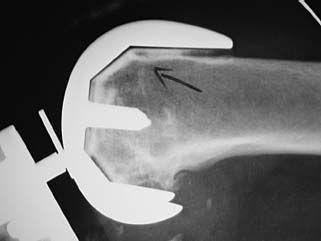FIGURE 37-1. Unstable total knee
During the primary procedure, if the posterior cruciate and the medial collateral ligaments are of questionable integrity, they should be substituted for with the appropriate level of constraint. As the level of total knee component’s constraint increases, the stresses within the knee are transferred to the boneimplant interface or the locking mechanism of the polyethylene insert. With this in mind, surgeons should use the least amount of constraint required to obtain a stable construct.
Equalization of the flexion–extension gaps is paramount. The concept of leaving the flexion gap looser than the extension gap to promote early return of motion is discouraged as it frequently leads to late symptomatic flexion instability, requiring revision surgery to correct. With the increased use of mobile bearing designs, attention to soft tissue balancing becomes even more critical. Total knee replacements should be considered more of a soft tissue balancing procedure than an exercise in boney carpentry.
Infection. Similarly, early infection can be viewed as a somewhat preventable complication. Because septic failures have a less successful outcome after revision than aseptic failures,14,15 particular attention must be paid to reducing this mode of failure. Early infections are likely perioperative in nature as compared to late infections, which most likely result from hematogenous seeding.
Prevention of early infection demands attention to detail perioperatively. The patient must not have remote sites of infection before elective surgery, and an assessment of a patient’s nutritional status could help identify those with a tendency for wound healing problems. A preoperative total lymphocyte count <1,500 cells/mm3, a serum albumin level <3.5 g/L, or adiminished serum transferrin level all have been associated with increased prevalence of wound complications.13 Postoperative wound complications such as persistent drainage, delayed healing, or hematoma have been linked to an increased risk of infection16 (Fig. 37-2). Consequently, aggressive treatment of such problems could lower the incidence of early infection. Moreover, because comorbidities such as rheumatoid arthritis, obesity, and diabetes increase the risk of infection following joint arthroplasty, extra vigilance in the management of such patients is mandatory to improving results.17

FIGURE 37-2. Infected total knee.
Continued review of intraoperative sterility and techniques is also vital. Minimizing traffic in the operating room; appropriate use of hoods, masks, gowns, and gloves; use of an adhesive iodophor drape; and the use of pulsatile antibiotic irrigating solution all have been shown to decrease bacterial contamination.18–25 Perioperative antibiotics and the use of antiobioticloaded cement in high-risk patients have also been shown to decrease infection rates.26 Surgery done efficiently with meticulous handling of soft tissues also should help minimize this early complication.
Aseptic Loosening. Aseptic loosening occurs in both cemented and cementless components but typically at different times and with different frequencies. Cementless components fail due to aseptic loosening more frequently than cemented components, and the failure usually occurs in the early postoperative period, often due to failure of bone ingrowth of the porous-coated implant. Duffy et al.27, using identical implant designs, reported higher failure rates for cementless (28%) as compared to cemented components (6%) at 10 years (Fig. 37-3). The Swedish registry reported the risk of revision as 1.4 times higher for cementless implants.28

FIGURE 37-3. Aseptic loosening—cementless.
Failure due to aseptic loosening of cemented components occurs less frequently and usually occurs late, often because of osteolyis or varus malalignment15 (Fig. 37-4
Stay updated, free articles. Join our Telegram channel

Full access? Get Clinical Tree








